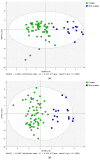A Study of Greek Graviera Cheese by NMR-Based Metabolomics
- PMID: 37513360
- PMCID: PMC10385548
- DOI: 10.3390/molecules28145488
A Study of Greek Graviera Cheese by NMR-Based Metabolomics
Abstract
Graviera is a very popular yellow hard cheese produced in mainland Greece and the Aegean islands, and in three PDO (protected denomination of origin) locations. Apart from geographic location, type of milk and production practices are also factors that affect cheese composition, and make this dairy product unique in taste and aroma. In this work, 1H nuclear magnetic resonance (NMR) spectroscopy in combination with chemometrics has been used to determine the metabolite profile (40 compounds) of graviera cheese produced in different geographic locations, with emphasis on cheeses produced on the island of Crete. Organic acids and amino acids were the main components quantified in the polar cheese fraction, while the fatty acid (FA) composition of the lipid fraction was also obtained. Analysis of variance (Anova) of the dataset showed that γ-aminobutyric acid (GABA), conjugated linoleic acids (CLA) and linoleic acid differentiate gravieras produced in different areas of Crete, and that the total amino acid content was higher in cheeses produced in eastern Crete. Targeted discriminant analysis models classified gravieras produced in mainland Greece, Cyclades and Crete based on differences in 1,2-diglycerides, sterols, GABA and FA composition. Targeted and untargeted orthogonal partial least squares discriminant analysis (OPLS-DA) models were capable of differentiating gravieras produced in the island of Crete and hold promise as the basis for the authentication of PDO graviera products.
Keywords: NMR spectroscopy; amino acids; fatty acids; graviera cheese; metabolite profile; metabolomics; multivariate analysis.
Conflict of interest statement
The authors declare no conflict of interest. The funders had no role in the design of the study; in the collection, analyses, or interpretation of data; in the writing of the manuscript; or in the decision to publish the results.
Figures







References
-
- EC Commission of the European Communities. Commission Regulation (EC) No 1107/96 of 12 June 1996 on the registration of geographical indications and designations of origin under the procedure laid down in Article 17 of Council Regulation (EEC) No 2081/92. Off. J. Eur. Commun. 1996;39:1–10.
-
- McSweeney P.L.H., Fox P.F., Ciocia F. Chapter 16—Metabolism of Residual Lactose and of Lactate and Citrate. In: McSweeney P.L.H., Fox P.F., Cotter P.D., Everett D.W., editors. Cheese. 4th ed. Academic Press; San Diego, CA, USA: 2017. pp. 411–421. - DOI
-
- Fox P.F. Proteolysis during cheese manufacture and ripening. J. Dairy Sci. 1989;72:1379–1400. doi: 10.3168/jds.S0022-0302(89)79246-8. - DOI
-
- Collins Y.F., McSweeney P.L.H., Wilkinson M.G. Lipolysis and free fatty acid catabolism in cheese: A review of current knowledge. Int. Dairy J. 2003;13:841–866. doi: 10.1016/S0958-6946(03)00109-2. - DOI
-
- Tzora A., Nelli A., Voidarou C., Fotou K., Bonos E., Rozos G., Grigoriadou K., Papadopoulos P., Basdagianni Z., Giannenas I., et al. Impact of an Omega-3-Enriched Sheep Diet on the Microbiota and Chemical Composition of Kefalograviera Cheese. Foods. 2022;11:843. doi: 10.3390/foods11060843. - DOI - PMC - PubMed
MeSH terms
Substances
Grants and funding
LinkOut - more resources
Full Text Sources

